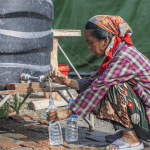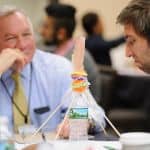Breaking Out of the Social Impact Conference Rut: Five Ways to Design a Truly Impactful Event
Addressing the world’s biggest and most challenging issues at the intersection of subsistence and sustainability requires moving beyond silos – not only between disciplines, but between research and practice. Conferences can catalyze this effort, allowing participants to connect with others working in social impact – regardless of their sector, geography or mission – to learn vital new insights about one another’s work.
But for this to happen, the conference must avoid some pitfalls common to social impact-focused events – many of which are likely familiar to anyone who has made the rounds on the development conference circuit.
The Subsistence Marketplaces Initiative (SMI) at the Gies College of Business, University of Illinois, Urbana-Champaign recently brought together academic researchers, social innovators, entrepreneurs, educators and students from six continents at the Seventh Subsistence Marketplaces Conference. Along with this biennial conference series, we also ran the First Subsistence Marketplaces Bottom-Up Immersion Conference in India earlier this year.
Here are some lessons these events have taught us about how to convene discussions that can impact people, products and poverty-related practice around the world.
Start at the micro-level
We began the Subsistence Marketplaces conference series in 2006 with an ambitious goal: Create a sustained platform for simultaneously addressing high-level research and education, while also keeping the discussion grounded in the day-to-day realities of people living in poverty. This required us to invert the traditional focus of many global development conferences: Instead of looking at the issue from 30,000 ft. and then drilling down to find solutions, we realized it was essential to begin at the micro-level, seeking to understand people who barely make ends meet in the context of the marketplaces they create.
Operating from the bottom-up allows participants to gain micro-level insights about consumers, entrepreneurs and marketplaces and then derive implications for the meso (e.g., product development, enterprise models), and macro (e.g. public policy) levels. It’s important to study these marketplaces in their own right, and inside-out, rather than as a means to some other end. But how can a conference execute this shift in focus?
Create immersive, interactive experiences
There are limits to how long anyone can sit and listen to a series of panel discussions – no matter how interesting the topic or insightful the participants. That’s why we root people in our discussions through immersive and interactive experiences. We create poverty simulations, multi-media based immersions and recently, augmented reality experiences that focus on curricular innovations and social enterprise. There are no long presentations; instead we conduct discussion-oriented research sessions with short presentations, less delivery and more conversation. Our panels aren’t only individual takes on a subject; we facilitate conversation as well.
For example, we kicked off this year’s biennial conference with a poverty simulation in which participants took on the roles of people living in poverty in the U.S. over four weeks. Each week was simulated by 10-15 minutes in making ends meet. At the end of the experience, participants were asked to consider what they did, how they felt and what they learned about poverty. Many of the attendees who participated in these simulations later told us that playing the role of someone living in poverty had prepared them for the discussions to come by grounding them in the subject matter.
Create dialogue from multiple perspectives
Have you ever had the experience of deja vu when perusing an upcoming conference agenda and panelist line-up? It’s not just you: There really is a lot of overlap in the people and perspectives they feature. By contrast, we try to take a more interdisciplinary and inter-sectoral approach. We draw people from a variety of disciplinary backgrounds, not only in business and the social sciences, but in technical disciplines as well. Meeting challenges in subsistence domains, such as water and agriculture, requires the broadest of these interdisciplinary approaches.
It also requires a truly inter-sectoral group of participants. To achieve this, we bring together researchers, educators, students, practitioners – and even, sometimes, community representatives such as tribal members, to educate us about ground-level realities. This, in turn, means that the conversations approach the challenges of poverty from a variety of perspectives, which can be an enlightening experience for panelists and audience members alike.
Get out of your comfort zone
Challenging issues should lead to challenging discussions – if a conference doesn’t lead you to question some of your assumptions, it’s probably not going to deliver lasting value. That’s why, for every academic discussing their latest research at our events, there is someone with a different perspective based on their experiences on the ground, educating both students and practitioners. This leads to conversations that take us out of our comfort zones.
These conversations may involve social entrepreneurs from arenas such as nutrition, energy and agriculture, providing invaluable perspective from their practice in different domains of subsistence. They may involve researchers in a variety of disciplines presenting cutting-edge research from different geographies, or addressing how to measure the impact of subsistence and sustainability efforts. Sometimes they can even involve individuals who are immersed in the very challenges under discussion, like refugees from Nakivale, Uganda who led our marketplace literacy program there, and who participated as experts in the workshop on social innovation at our event this year.
Sustain a platform
Even the most stimulating event can deliver diluted impact if there’s no effort to channel its connections and discussions toward ongoing action. That’s why, at our conferences’ end, we map out the question: “Where have we been and where should we go from here?” Our goal is to help our ideas collectively move forward in confronting the burning challenges in the development arena.
We promote this ongoing discussion via a unique information stream pioneered by SMI, which creates synergies between research, education and social enterprise. In addition to our broader call for papers for the conferences, we have edited special issues of journals with numerous publications to date. We also host a web portal with a variety of educational materials — everything from day-in-the-life videos and immersion exercises to an online poverty simulation. And our parallel social enterprise has provided marketplace literacy education to tens of thousands of people in nine countries. These efforts not only give practitioners but also scholars – particularly junior ones – a way to share their work with a broader audience.
Indeed, our approach is a symbiotic academic/social enterprise, at one end of the continuum of bringing research, education and practice together. SMI has pioneered this bottom-up approach to research and practice at the intersection of poverty and marketplaces, and we believe it’s reflected in the events we organize. We’re already looking forward to our next immersion conference in Tanzania in 2019.
Madhu Viswanathan is the Diane and Steven N. Miller Centennial Chair in Business at the Gies College of Business at the University of Illinois, Urbana-Champaign.
- Categories
- Social Enterprise, Uncategorized



